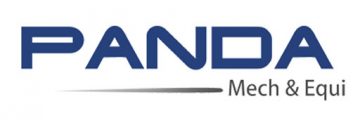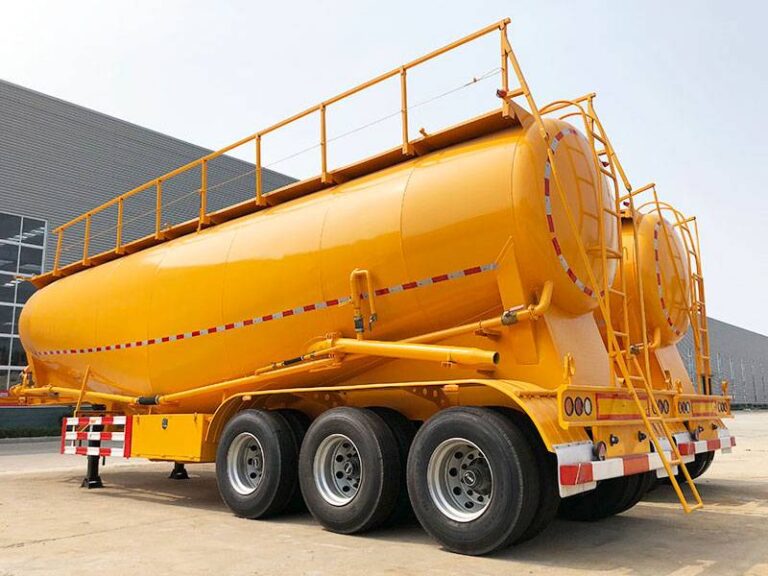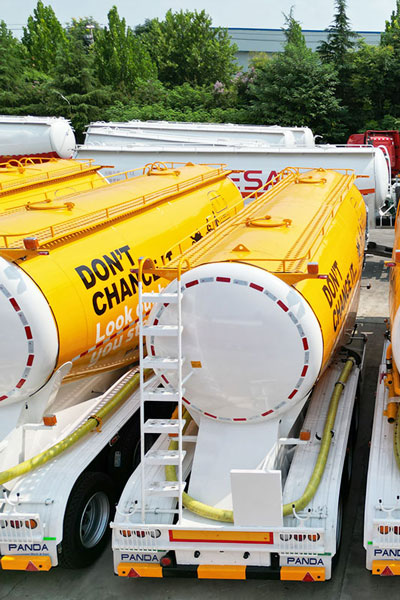Cement is one of the more used materials nowadays and when we buy it it comes in bags and has its own packaging, so do you know about bulk cement transport trucks? It is actually transported directly to the customer by transport equipment without special packaging.The following article will give you information on bulk cement transportation, which I hope will be of help to you.

What is bulk cement transport?
Compared to bagged cement transport, bulk cement transporter truck is simple and convenient, safe and environmentally friendly, and mechanically unloaded. Bulk cement does not require packaging or manual loading and unloading, so it is necessary to set up a bulk cement storage tank at the concrete mixing plant on site and load and unload the cement in the tanker truck by means of an air compressor.
Matters needing attention in bulk cement transportation?
- Cement should not be damped and mixed with debris during transportation and storage. Different types and grades of cement should be stored and transported separately.
- The warehouse storing cement should be protected from moisture and rainwater leakage; when storing bagged cement, the floor pad should be 300mm off the ground and 300mm from the wall around it; the bagged cement should not be stacked too high to prevent the lower cement from being compressed and hardened , Generally, 10 bags are appropriate. If the storage period is short and the warehouse is tight, it should not exceed 15 bags.
- The storage of cement should be in accordance with the order in which the cement arrives, and it should be stacked in sequence, and try to store it first and use it first.
- The storage period of cement should not be too long, so as to avoid moisture and reduce the strength of cement;
The general cement storage period is 3 months, the high alumina cement is 2 months, and the fast hardening cement is 1 month.

Bulk cement transport loading
Put on protective gear, check the safety of the surrounding environment, open the exhaust valve of the tank, open the cover of the silo kiln and start loading cement by aligning with the bulk loading port of the silo, close the cover of the silo kiln after the tank is full, close the exhaust valve and finish loading bulk cement.
Loading steps
- First open the pressure relief ball valve to discharge the remaining compressed air in the tank, then open the charging port cover, place the filter screen, and then put cement into the tank.
- After the loading is completed, wipe off the cement on the sealing ring of the feeding port, cover the charging port and press it tightly, and close the pressure relief valve.
- At the same time, close the discharge butterfly valve to avoid cement overflow during transportation.

Bulk cement transport
Walk safely to the destination according to the driving rules of the car, park the car on a flat road, and try not to tilt the tank forward or backward or left and right.
Cement truck unloading
When unloading bulk cement, check that the tanker is in a stable position and the air compressor is stable, so that the unloading port of the tanker is aligned with the receiving port of the cement storage bin, start the air compressor to blow compressed air into the tank, when the pressure gauge shows that the pressure inside the tank reaches 0.2Kpa, start to put cement. During the normal unloading of cement, the pressure indication will not change much. When the pressure indication gradually decreases to zero, a small amount of cement air mass will be emitted from the tank outlet, indicating that the unloading of cement is completed.
Bulk Cement Transporters unloading Video
Bulk cement transporters unloading steps
- Connect the unloading pipe, and pad the sealing ring when connecting the unloading pipe. Open the air inlet valve of the front and rear air chambers, close the pressure relief ball valve, the external air source ball valve, the secondary air ball valve and the discharge butterfly valve.
- Start the engine smoothly and make the air compressor start smoothly at low speed. Then gradually increase the throttle to make the air compressor reach the rated speed and inflate the tank.
- When the pressure rises to about 0.15MPa, open the secondary air ball valve to clear the discharge pipeline, and then close the secondary air ball valve after confirming that the discharge pipeline is not blocked.
- When the pressure drops to 0.2MPa, open the discharge butterfly valve to start discharging.
- When the pressure drops to about 0.02MPa and no longer drops, it indicates that the cement in the tank is basically unloaded, and the warehouse starts to be cleaned.
- Close the air inlet valve of the front air chamber, and only let the air in the rear air chamber. Observe the pressure gauge. If the pressure value rises, it indicates that there is still residual material at the rear of the tank. After the pressure rises, it will drop to about 0.02MPa again. When it is lowered, it indicates that the rear is unloaded.
- If the pressure does not rise, the rear has been unloaded. After confirming that there is no residual material at the back of the tank, open the front air chamber inlet valve, and close the rear air chamber inlet valve to clean the remaining material at the front of the tank.
- Observe the pressure gauge. If the pressure value rises, it means that there is residual material in the front of the tank. When the pressure rises and then drops back to about 0.02MPa, it means that the front part has been cleaned. If the pressure value does not rise, it means that there is no remaining material at the front.
- After confirming that there is no remaining material in the front and rear of the tank, turn off the engine, stop the air compressor, open the pressure relief ball valve, close the discharge butterfly valve, remove the discharge quick connector, put the discharge hose back on the car, and complete Unloading work.

Check whether the bulk cement tanker trailer is unloaded cleanly
After opening the exhaust port and exhausting the remaining gas in the tank, open the bulk cement transporters tank lid and check whether the unloading is clean with you.

How to transport cement
Usually cement plants use bulk cement transportation/bulk cement transport truck.
After the cement is produced in the cement factory, the cement is sent to the bulk cement tanker using pneumatic equipment.
8 points to consider in cement bulk transporters trailer transport
1、Do not run at excessive speed or pressure when driving a bulk cement transporters; excessive speed or pressure can seriously damage the air compressor.
2、Don’t start or stop the air compressor quickly, but increase the speed or decelerate slowly, otherwise, the punching pressure will damage the air compressor.
3、Do not change the direction of rotation of the air compressor, otherwise, the oil pump will not supply oil which will seriously damage the machine.
4、Do not stop the air compressor before decompression, otherwise, powder and granular materials may flow backwards into the cylinder and cause serious damage to the air compressor.
5、Check the oil mark before starting the machine. The oil level should not be lower than the lower limit of the oil mark; it is necessary to check frequently whether the oil pump is supplied with oil, if not, it should be stopped immediately for inspection, otherwise, the lack of oil will seriously damage the air compressor.
6、The lubricating oil should be replaced on a regular basis. After using the new machine for 30 hours, discharge the oil in the crankcase, clean the inside of the crankcase and the oil filter, and then change the oil. In future, change the oil once a year as described above.
7、Check and clean the oil filter. Under normal circumstances, it should be checked and cleaned once a quarter, if the machine usage rate is high, it should be checked and cleaned once a month.
8、Maintain and clean the air filter every 30 hours of work. While turning the filter element, blow it from inside to outside with compressed air with a pressure of less than 0.6MPa. After five times of maintenance, please replace the cartridge with a new one. It is strictly forbidden to clean the cartridge with oil or water.

How to clean the bulk cement transporters?
Bulk cement transportation generally does not need to be cleaned, because the powder we pull can be unloaded when it is unloaded. If there is a small amount of residue, it is harmless, no problem. If it is generally cleaned, it can be cleaned directly with water. It is very simple. Generally, the driver will go to clean the tanker.
There are very few companies on the market that are cleaning tankers. They usually clean themselves up, and few people spend money.
Ok, today’s How to loading, unloading bulk cement transporters is over here. If you have any questions about bulk cement transport truck in this regard, you can always contact us panda mech bulk powder transport companies. If you want to buy bulk cement transport near me , you can email us directly or leave a message.









